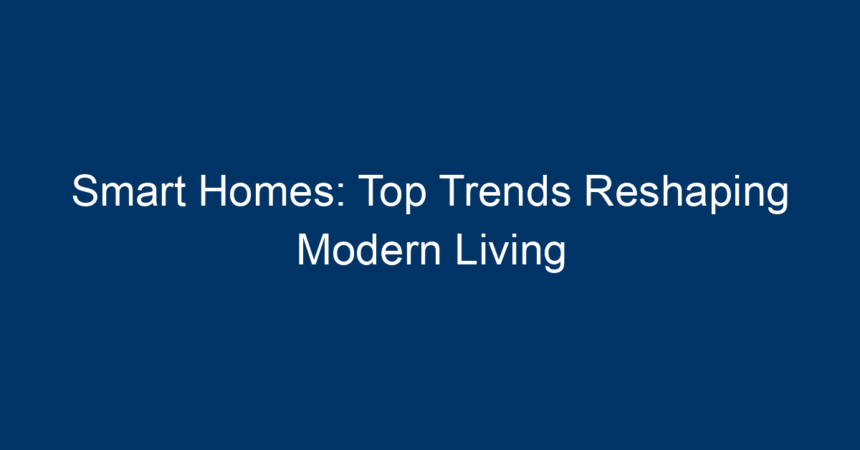The concept of smart homes is rapidly evolving, reflecting our growing desire for convenience, efficiency, and security. As technology advances, more homeowners are embracing smart devices that not only enhance comfort but also contribute to sustainable living. In this article, we delve into the top trends reshaping modern living through smart homes, exploring innovations and practices that will improve your lifestyle.
Understanding Smart Homes
Before we explore the trends, let’s define what smart homes are. A smart home utilizes internet-connected devices to enable remote management and monitoring of systems and appliances. Increased connectivity allows homeowners to control lighting, security, heating, and appliances from their smartphones or computers, creating an integrated living experience that simplifies daily tasks.
The Rise of Voice Assistants
The Smart Home Command Center
Voice assistants like Amazon Alexa, Google Assistant, and Apple’s Siri have taken center stage in many smart homes. These digital helpers allow users to control various aspects of their home hands-free. From changing the thermostat settings to playing music, the convenience of voice commands enhances user interaction with smart home devices.
Seamless Integration
One of the key reasons for the proliferation of voice assistants is their compatibility with numerous smart gadgets. Homeowners can use voice commands to manage everything from smart bulbs to security cameras, making their living spaces not only smarter but also more user-friendly. An effective voice control system effectively minimizes the need for complex remotes or apps, streamlining operations and creating a cohesive environment.
Energy Efficiency and Sustainability
Smart Energy Management Systems
As environmental awareness increases, more individuals are turning to smart homes for energy efficiency. Devices such as smart thermostats and energy monitors help users track and reduce their energy consumption. Smart thermostats can learn your heating and cooling preferences over time, ensuring optimal comfort while saving on energy costs.
Eco-Friendly Appliances
Incorporating energy-efficient appliances is another trend in smart homes. Devices that comply with Energy Star ratings consume less energy, which not only lowers utility bills but also benefits the environment. Smart washers and refrigerators, for instance, optimize water and energy usage, fostering a sustainable lifestyle.
Enhanced Security Features
Smart Surveillance Systems
The safety of loved ones and possessions is paramount in any home. Smart homes offer advanced security features such as smart cameras, doorbells, and locks. These systems can be monitored in real-time through smartphones, enabling homeowners to keep an eye on their property even when they’re away.
AI-Powered Alerts
Artificial intelligence is becoming increasingly integral in smart home security. AI-enhanced systems can differentiate between regular activities (like a family member returning home) and potential threats (such as an unfamiliar person on the property). This capability allows for rapid alerts, enhancing home security and providing peace of mind.
The Internet of Things (IoT)
Connected Devices for a Seamless Experience
The Internet of Things (IoT) is the backbone of smart homes. This network of connected devices allows for seamless communication between appliances, creating an integrated ecosystem. For example, your smart coffee maker can start brewing as soon as your alarm goes off, or your smart blinds can open at sunrise.
Automation and Scheduling
Smart homes are not just about convenience; they can also learn and adapt to your lifestyle. Automation allows homeowners to set schedules for specific tasks, like turning off lights or adjusting the thermostat when everyone leaves for work. This functionality not only enhances efficiency but also contributes to significant energy savings.
Health and Wellness Innovations
Smart Air Quality Monitors
As health becomes a growing priority, many homeowners are turning to smart homes for solutions. Smart air quality monitors can detect pollutants and allergens in the home, enabling users to take necessary actions to improve indoor air quality. Whether through air purifiers or ventilation systems, these devices create healthier living environments.
Sleep Technology
Innovations in sleep technology are also making their way into smart homes. Smart mattresses and sleep trackers offer insights into sleep patterns, providing recommendations to improve sleep quality. Features like adjustable firmness and built-in climate control cater to personal comfort, fostering a restful environment ideal for rejuvenation.
Home Automation and Smart Hubs
Central Control Panels
Smart hubs act as central control panels for smart homes, integrating multiple devices into one easy-to-manage system. These hubs allow homeowners to set up automated routines, manage device interactions, and monitor energy consumption from a single interface. Popular options include Google Nest Hub, Amazon Echo Plus, and Samsung SmartThings.
Scenarios and Routines
Creating automation routines is one of the most valuable capabilities of a smart home. For instance, a “Good Night” routine can turn off all lights, secure doors, and lower the thermostat with a single voice command. Such scenarios not only simplify daily activities but also enhance the efficiency and security of your home.
Trend Towards Home Offices
Smart Workspaces
The rise in remote work has led to a surge in demand for smart homes designed for productivity. Smart office setups integrate technology that supports seamless communication and collaboration. From smart speakers to adjustable standing desks, a modern home office benefits from thoughtful automation and connectivity.
Productivity-Enhancing Devices
Smart lighting and climate control can create an engaging work environment that fosters productivity. Smart devices can be programmed to adjust throughout the day, reducing eye strain and maintaining ideal temperatures for optimal focus.
Affordability and Accessibility
Budget-Friendly Smart Devices
One of the most notable trends in smart homes is the influx of affordable smart devices. As technology advances, prices for effective smart home solutions have decreased, making them accessible to a wider audience. From smart bulbs to affordable security cameras, homeowners can create a connected environment without breaking the bank.
User-Friendly Interfaces
Many smart devices now feature user-friendly interfaces that simplify installation and operation. This accessibility encourages more individuals to invest in smart technology, contributing to the growth of smart homes in various demographics.
Conclusion: Embrace the Future of Smart Homes
Smart homes are reshaping modern living, driven by trends that prioritize convenience, efficiency, and safety. As technology continues to advance, embracing these innovations can enhance your lifestyle while making a positive impact on the environment.
Actionable Insights
-
Research Smart Devices: Start by exploring the devices that best meet your needs, from smart lighting to security systems.
-
Set a Budget: Determine your budget for home automation to prioritize essential devices.
-
Plan Your Setup: Think about how you want your smart devices to interact. Lay a solid foundation for automation and routines.
- Stay Informed: Regularly update your smart devices and stay abreast of new technologies to keep your home current.
Embracing the trend of smart homes not only elevates your everyday living experience but also paves the way for a sustainable and efficient future.




